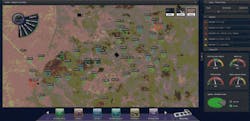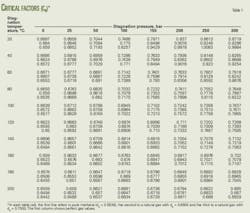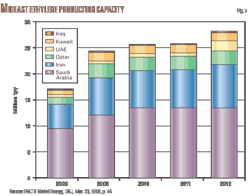From our assessment, the gas structures damaged during Hurricanes Gustav and Ike in the Gulf of Mexico present better economics and redevelopment potential than oil structures, and we predict that companies will redevelop 196 million boe, or nearly 95% of the remaining reserves.
Each destroyed structure is a candidate for redevelopment and is unique in its production capacity and damages incurred.
During August and September 2008, Hurricanes Gustav and Ike passed through the gulf and damaged and destroyed many offshore oil and gas structures.
The final official government assessment listed 60 destroyed platforms and 31 extensively damaged structures. The destroyed platforms represented 1.6% of the oil and 2.5% of the gas produced in the gulf. Remaining reserves from these platforms are estimated at about 234 million boe valued between $4.6-10.9 billion.
Although the number of structures destroyed by Hurricanes Gustav and Ike was half the total destroyed from the 2004-05 hurricane seasons, we estimate that the reserves at risk are about twice as large and three times as valuable.
Hurricanes
Powered by heat from the sea, a hurricane acts as a gigantic heat engine transforming warm ocean water into powerful wind fields. Hurricanes are typically about 300-350 miles wide and have extreme horizontal pressure gradients that generate powerful winds.
Wind speed and precipitation intensity both increase toward the center and generate waves and currents that stress offshore structures and may lead to catastrophic failure.
Hurricane force winds usually extend 25-50 miles on each side of the storm path and represent approximate boundaries where structures are most vulnerable. Typically, hurricanes destroy 2-4% of structures exposed to hurricane force winds and damage another 3-6%.
Old structures especially are vulnerable because these facilities have lower environmental criteria designs.
Structures fail in different modes and any wells underneath the deck and substructure usually bend at the mud line and require complex and expensive intervention to abandon.
Hurricanes may topple structures completely (Fig. 1) or leave the jacket structure standing (Fig. 2). Platform owners often declare leaning structures as destroyed (Fig. 3). In some cases, they may also declare as destroyed severely damaged structures that no longer can carry out their function.
In all cases, destroyed platforms present a hazard to navigation and require immediate identification as navigation hazards.
Hurricane Gustav entered the Gulf of Mexico on Aug. 31, 2008, as a Category 4 storm and exposed about 677 platforms to hurricane force winds (Fig. 4). Hurricane Ike followed in Sept. 13, 2008, as a Category 4 hurricane and exposed about 1,450 structures to hurricane force winds (Fig. 5).
The final official government assessment listed 60 destroyed structures and 124 extensively or moderately damaged structures.1
Data source
Following every major hurricane, the MMS issues Notices to Lessees (NTLs) that require platform owners to perform above and below water inspections of infrastructure exposed to hurricane-force winds.
For platforms exposed to hurricane-force winds, MMS requires owners, in accordance with the API Recommended Practice 2A-WSD, to conduct a Level I survey (above water visual inspection) before manning. If damage occurred, MMS also may require additional surveys such as underwater visual inspection, close visual inspection of areas of known or suspected damage, or underwater nondestructive testing.
Platform owners report the inspection results to MMS and indicate if platforms had no damage, incurred minor or major damage, or were destroyed.
The MMS coordinates with the platform owners who report on their assessment on a periodic basis. The MMS final official list reports the total number of damaged and destroyed platforms by category. Our analysis used these public data.1
The number of platforms declared destroyed usually increases over time, but upon release of the final official list, typically 8-12 weeks after the event, platform owners have finished most of their damage assessments.2 3 The data set still may be incomplete when MMS releases the official list because a platform owner may require additional time to determine the economics of replacing the structure or it may uncover additional damage to the structure overlooked in the initial inspection.
An owner also may remove a structure if a pipeline or platform that was part of the operation scheme is no longer in service or removed from service later.
Destroyed structures
Offshore structures have designs that meet the environmental conditions in which they operate. The platforms have an extremely good day-to-day operational safety record and historically have met an acceptable rate of failure.
With the appearance of a tropical storm or hurricane, however, the risks of damage and destruction increase dramatically because structures must sustain wind speeds, wave forces, and potential mudslides that in extreme circumstances may equal or exceed their design capacity.
Old structures in particular are vulnerable because they have designs usually with lower environmental criteria than current designs. A wave crest hitting a platform deck creates very large loads that likely will damage and in some cases collapse a platform. A key ingredient for a platform to survive a hurricane is for the deck to have an elevation above the largest hurricane waves.
Platform owners must decommission destroyed structures for removal. The work is challenging and needs to be undertaken in a way that ensures no harm to people, property, or the environment.4
Decommissioning costs of destroyed structures often are 5-25 times more than conventional abandonment. Likewise, risks are much greater.
Decision-making economics
If the estimated value of remaining reserves exceeds the expected cleanup and redevelopment cost, companies likely will redevelop the field. The field has little or no exploration risk, and for a young field, higher production rates are possible. These higher rates may help offset the capital expenditures of the redevelopment.
Companies likely will redevelop assets capable of producing at high rates or having more remaining reserves because these will have better economics than fields with low production rates or fewer reserves. In some cases, new drilling opportunities may arise that will improve the redevelopment economics.
A rational operator would not spend more than the estimated value of remaining reserves to replace a destroyed structure or repair a damaged structure.
Fields early in their lifecycle likely will support the production rates and reserves necessary for redevelopment. Mature assets and small producers are least likely to meet the economic thresholds, and in most cases, will face abandonment.
Companies make all decisions on a case-by-case basis on criteria such as cost information, reservoir formations, redevelopment opportunities, and other proprietary data generally unavailable in the public domain.
The decision to repair, replace, or decommission damaged and destroyed infrastructure is often difficult because of the uncertainty involved in estimates. The return on investment that a company expects to receive depends upon future production rates and hydrocarbon prices, as well as on the cost to clean up and redevelop the site.
Under normal circumstances, redevelopment decisions are no different from an initial development decision, but in the case of destroyed or severely damaged assets, companies need to account for additional complications and uncertainties regarding the procedures and costs. They have to weigh all costs against the potential revenue generating capability expressed through the remaining reserves, expected production levels, and future prices.
Production classification
One can classify offshore structures in different ways, but using the physical aspects of the infrastructure and the characteristics of the production stream is the most common.
An active structure is one that produces any amount of oil or gas during the year, while an idle structure is one that once produced hydrocarbons but has had no production for at least 1 year.
Auxiliary structures are structures that never have had production and serve in a support role such as a storage, compression, or metering facility.
GOR is a common means for classifying reservoir fluids and field production. We classify oil-producing structures as ones that produce with a GOR less than 5,000 scf/bbl. Gas structures are those producing with a 5,000 scf/bbl or greater GOR.
The units for the combined oil and gas production are in barrels of oil equivalent based on heat content (1 bbl = 6 Mcf).
Shut-in production
Figs. 6a and 6b depict the shut-in oil and gas profiles in recent storms as a percent of daily production at the time of the event. Shut-in curves may have more than one peak depending on the timing of successive events. If a second storm enters the gulf before operators assess damage or restart production, then the shut-in curve will have two peaks.
In 2005, Katrina, Rita, and Wilma occurred in quick succession, and the shut-in profile has three distinct bumps. In 2008, Ike followed Gustav within 2 weeks.
The speed of the approaching storm and collective operator response determines the upward slope of the shut-in curve. The storm’s impact on the offshore and coastal infrastructure determines the downward slope and the speed at which the curves approach the origin.
If the storm destroys much infrastructure (structures, pipelines, gas processing facilities, and refineries), production will remain offline and the shut-in curve will not return to the origin during the period sampled.
If the storm causes no damage to offshore infrastructure or onshore gas processing plants and refineries, then shut-in production will approach zero and operations will resume without loss of production.
The term “lost production” refers to production associated with destroyed structures that companies plan not to redevelop.
Hurricane impact
MMS’s final tally listed 60 structures destroyed by Hurricanes Gustav and Ike. Of these, one-third (20) were idle, meaning that they had no production on them for at least 1 year before the hurricanes. Nine structures never had production and are auxiliary, nonproducing structures.
Companies are unlikely to redevelop idle structures because in most cases they have extracted all the commercial reserves at the site and will schedule decommissioning of these structures when the lease stops producing.
The nine auxiliary structures served in a nonproducing role and depending on the facility requirements and redevelopment options, companies may or may not reinstall them.
Fixed platforms producing gas were the most common structure destroyed (Table 1). About 60% of these structures were 25 years or older (Table 2).
We classify as idle structures, the structures without any producing wells in 2007 since these structures did not have any production in 2006.
Idle age is the time since last production. For our list of destroyed idle structures, the average idle age was 7.8 years.
Half of active structures have two wells or fewer producing.
Our estimate is that the 76 oil and 74 gas wells shut in produced 15,446 bo/d and 136.58 MMcfd of gas, or 1.59% of the oil and 2.54% of the gas produced in the gulf.
Our daily production estimates differ from the MMS estimates of 13,657 bo/d and 96.49 MMcfd.1
Production, revenue statistics
Table 3 presents the average prehurricane daily production and revenue based on calculated production 1 year before each hurricane and normalized on a daily basis.
For calculating the average daily and annual revenues, we used monthly average oil and gas prices reported by the Energy Information Administration and then adjusted them based on the consumer price index through August 2008.
We did not adjust prices for quality differences in gravity and sulfur content, or applied a location differential to estimate netback prices.
The estimated revenue from the 31 producing structures is $2.1 million/day or $753 million/year. Table 4 summarizes daily production.
Composite production profiles
Fig. 7 shows the aggregated oil and gas production profiles for all structures destroyed by Gustav and Ike. The aggregation leaves out production from McMoRan Exploration Co.’s 23925 structure, shown separately, because the company will likely redevelop the sizable remaining reserves.
We estimated the remaining reserves and associated discounted gross revenue under constant future price scenarios and a discount rate of 10% for each asset. Production models specific to each structure estimated remaining reserves using a combination of forecast methods and heuristic techniques. Discounted revenue calculations assumed first revenue would occur 1 year after initial investment.
Table 5 presents reserves as a range based on future prices that vary from $60 to $140/bbl. Remaining reserves estimates show varying degrees of sensitivity to changes in future prices depending on the age of the asset and nature of the production profile, but in aggregate, the amount of variability is unremarkable because of the assumption that after redevelopment companies will expend no additional capital to increase or enhance production.
For several assets (Structures 305, 927, 1286, 21009, and 23009), initial revenue fell below the structure’s revenue threshold or economic limit, and therefore future production is not commercial and depicted as zero.
It is possible that companies may identify additional targets at these sites or redevelop them in conjunction with nearby fields, but such information was unavailable for analysis.
Discounted revenues increase significantly with changes in future prices. The analysis aggregates remaining reserves estimates and discounted gross revenue using three categories for redevelopment: unlikely, possibly, and most likely.
Companies likely will decommission structures with production of fewer than 100 boe/d, may redevelop structures with production between 100-1,000 boe/d, and likely will redevelop structures with production of more than 1,000 boe/d.
We selected these cutoff values from historical data based on the redevelopment rates of previous hurricane events.
At $60/bbl oil, companies may redevelop 31 millon boe and likely redevelop 201 million boe with discounted values of $677 million and $4.0 billion (Table 5).
At $100/bbl oil, companies may redevelop and most likely will redevelop reserves equal to $1.1 billion and $6.7 billion, respectively.
Redevelopment potential
Redevelopment strategies available to companies are site-specific. It is difficult or impossible to assemble many relevant factors such as the geologic conditions of the reservoir and drilling opportunities available, cleanup and redevelopment cost, and strategic decisions.
Fortunately, there are many other accessible factors with a reasonable degree of accuracy, such as production and drilling profiles and lease inventories.
Estimates of remaining reserves and valuations have a larger degree of uncertainty.
When a storm destroys a producing structure, most wells require abandonment. Depending on the lease infrastructure and processing and transportation options available, the operator may replace the structure and drill new wells. The operator may replace a structure at the original site or elsewhere on the lease or an adjacent lease, depending on field configuration.
A company may base the decision to redevelop on factors such as expected posthurricane production potential, estimated remaining reserves, probability of success, and cost of cleanup and redevelopment.
Our analysis assumes that prehurricane production provides a reasonable, first-order indicator of expected redevelopment potential. Estimated remaining reserves have a reasonable degree of certainty, while cleanup and redevelopment cost are unknown and uncertain. For each destroyed structure, we have plotted prehurricane production rates and expected remaining reserves (Fig. 8).
Each destroyed structure is a candidate for redevelopment and is unique in its production capacity and damages incurred. Idle structures fall on the vertical axis and are unlikely to be redeveloped.
Structures with positive prehurricane production rates and zero expected remaining reserves arise from modeling a structure’s entire production lifecycle and may or may not be redeveloped. Our working assumption is that companies are more likely to redevelop structures with large prehurricane production rates and remaining reserves.
We classify regions as redevelopment unlikely, possible, and probable and assign probabilities of occurrence to each region.
We base the estimated probability of redevelopment on previous hurricane events (Ivan, Katrina, and Rita). The ranges are 10-20% unlikely, 40-60% possible, and 80-90% probable.
Companies are unlikely to restart structures in the left most quadrant because the projects will have both low cash flows and low valuations. Structures residing in the possible and probable redevelopment regions have a greater likelihood of returning the capital expenditures required by the investment.
In the middle quadrant, where prehurricane production rates range from 100-1,000 boe/d and expected remaining reserves generally range from 10,000 to 20 million boe, structures have about a 50:50 chance of redevelopment.
Our analysis calculates expected remaining reserves by multiplying the reserve estimates by the anticipated redevelopment rates (pi), where i = 1, 2, 3 per category assumed, for instance p1 = 15%, p2 = 50%, and p3 = 90%.
The calculation for the expected value of the redevelopment opportunities assigns a probability vector to future prices. If (q1, q2, q3, q4) = (0.35, 0.35, 0.20, 0.10) corresponds to future price expectations of ($60/bbl, $80/bbl, $100/bbl, and $120/bbl), then E(P) = $74/bbl. Table 6 summarizes the expected value of gross revenue, E(REV).
Figs. 9a and 9b show the oil and gas production forecast for the collection of producing structures classified according to possible and probable redevelopments.
Our results are sensitive to the redevelopment of structure 23925 that is responsible for more than half of the total production potential.
References
- MMS completes assessment of destroyed and damaged facilities from Hurricanes Gustav and Ike, R-08-3982, MMS Office of Public Affairs, Nov. 26, 2008.
- Assessment of fixed offshore platform performance in Hurricanes Andrew, Lili and Ivan, TAR No 549, Energo Engineering Inc. report to MMS, 2006.
- Assessment of fixed offshore platform performance in Hurricanes Katrina and Rita, TAR No 578, Energo Engineering Inc. report to MMS, 2007.
- Beck, R.D., et al., “Imaging downed platforms,” Paper No. OTC 19650, OTC, Houston May 5-8, 2008.
- Laurendine, T.T. “Gulf of Mexico offshore platforms-risk engineering,” Paper No. OTC 19576, OTC, Houston, May 5-8, 2008.
- Mailey, J.F., “Technology and innovations contribute to safety and efficiency in storm disaster recovery,” Paper No. SPE 111563, SPE International Conference on Health, Safety, and Environment, Nice, France, Apr. 15-17, 2008.
- Lease Term Extensions Pursuant to 30 CFR 250.180(e) due to hurricane damage. NTL No. 2008-G24, effective date Dec. 31, 2008, expiration date June 30, 2009.
The authors
















